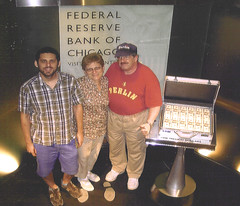
About UsThe Numismatic Bibliomania Society is a non-profit organization promoting numismatic literature. For more information please see our web site at coinbooks.org SubscriptionsThose wishing to become new E-Sylum subscribers (or wishing to Unsubscribe) can go to the following web page link MembershipThere is a membership application available on the web site Membership Application To join, print the application and return it with your check to the address printed on the application. Membership is only $15 to addresses in the U.S., $20 for First Class mail, and $25 elsewhere. For those without web access, write to: David M. Sundman, Secretary/TreasurerNumismatic Bibliomania
Society AsylumFor Asylum mailing address changes and other membership questions, contact David at this email address: dsundman@LittletonCoin.com SubmissionsTo submit items for publication in The E-Sylum, just Reply to this message, or write to the Editor at this address: whomren@coinlibrary.com
BUY THE BOOK BEFORE THE COINYou won't regret it! |
- WAYNE'S WORDS: THE E-SYLUM AUGUST 31, 2008
- THE E-SYLUM APPROACHES ITS 10TH ANNIVERSARY
- NEW BOOK: IDENTIFICATION DISCS OF UNION SOLDIERS IN THE CIVIL WAR
- NEW BOOK: THE EXCHANGE ARTIST: AMERICA'S FIRST BANKING COLLAPSE
- ANS NAMES ELIZABETH HAHN AS NEW LIBRARIAN
- ANTIQUES AUTHOR RALPH KOVEL DIES
- JOHN J. FORD AND THE FRANKLIN HOARD
- AUSTRALIA'S CHARLOTTE MEDAL PEDIGREED TO JOHN J. FORD
- ON CD (AND DVD) BOOK PUBLICATION
- ON COUNTING THE EDGE REEDS ON A COIN
- DICK JOHNSON ON COIN REEDING TECHNOLOGY
- MORE ON THE CASTINE HOARD
- PHOTOS: J.L POLHEMUS COUNTERSTAMP ON FRENCH COIN
- QUERY: J. T. JONES COUNTERSTAMP ON A $50 GOLD SLUG
- WILL W. NEIL, NUMISMATIST BY INSTINCT
- PISTRUCCI WATERLOO MEDAL ELECTROTYPES
- QUERY: SIX-POINTED STAR STAMP ON U.S. PAPER MONEY
- QUERY: TRANSLATION SOUGHT FOR 2004 ATHENS OLYMPICS GOLD MEDAL
- PRESIDENT BUSH GETS A COIN FROM THE CIA
- BASEBALL CARD COMPANY GIVES AWAY MONEY
- CORRECTIONS TO THE AUGUST 24, 2008 ISSUE
- FEDERAL RESERVE BANK OF CHICAGO EXHIBIT
- HOWARD BERLIN VISITS NUMISMATIC SITES IN SCOTLAND
- PHOTOS ILLUSTRATE ZIMBABWE'S INFLATION
- VIENNA'S MEDIEVAL SYNAGOGUE AND TOKENS
- JERUSALEM MAN ARRESTED FOR SELLING ANCIENT COINS TO TOURISTS
- COURT RULES CLEVELAND BUILDING LEASE IS PAYABLE IN GOLD
- OHIO COURT REFUSES PAYMENT OF FINE IN PENNIES
- FEATURED WEB PAGE: ORIENTAL COINS DATABASE
WAYNE'S WORDS: THE E-SYLUM AUGUST 31, 2008
 Among our recent subscribers is Greg
Culpepper, courtesy of John and Nancy Wilson. Welcome aboard! We now have
1,182 subscribers, and this week The E-Sylum celebrates an anniversary!
Among our recent subscribers is Greg
Culpepper, courtesy of John and Nancy Wilson. Welcome aboard! We now have
1,182 subscribers, and this week The E-Sylum celebrates an anniversary!
New books discussed this week cover topics including Union soldier identification discs and nineteenth century banking. In the news, the ANS names its new librarian, antiques book author Ralph Kovel has died, President Bush gets a "coin" from the CIA, and Howard Berlin visits the Chicago Fed and the Hunterian Museum in Glasgow.
In topics first broached in earlier E-Sylum issues, we discuss ephemera relating to the John Ford, book publication on CDs, the Castine Hoard and the recently discovered J.L. Polhemus counterstamp.
Answers to previous queries include several great responses on counting edge reeds. New queries relate to a counterstamp on a $50 gold slug, Pistrucci Waterloo medal electrotypes, and the inscription on a 2004 Athens Olympic gold medal.
To learn who once owned the unique Charlotte Medal, read on. Have a great week, everyone!
Wayne Homren
Numismatic Bibliomania Society
THE E-SYLUM APPROACHES ITS 10TH ANNIVERSARY
At first cataloguer Michael Hodder was the only other person to raise a hand. As they exchanged email addresses the others looked on like they were witnessing some secret ritual. In subsequent years a few more hands went up. Finally at the 1998 meeting in Portland, OR nearly every hand went up. Wayne grabbed a tablet of paper and passed it around to collect email addresses. On September 4, 1998 the first issue of what is now called The E-Sylum was published in an email message to 49 people. As the word spread subscription requests arrived from around the world and by September 15 there were 90 subscribers.
The original announcement noted "This is intended to be a moderated, low-volume mailing list, with no more than one message every week or so. Its purpose and use will evolve over time - please send us your comments and suggestions."
The E-Sylum has evolved into a weekly forum where "numismatic bibliophiles, researchers and just plain collectors" congregate to exchange information and ideas about numismatics and numismatic research. Most of the top numismatic authors, curators and collectors around the U.S. are subscribers, as well as a number from around the world. Today each issue is read by over 1,100 subscribers in the U.S., Canada, Mexico, England, Ireland, Wales, Germany, Denmark, Italy, Australia, New Zealand and elsewhere. It's been described as a weekly cocktail party of the world's top numismatic minds.
A typical issue could have anywhere from 15 to 30 pages of material arranged loosely into sections containing Numismatic Bibliomania Society news and announcements, numismatic literature sale announcements, book publication announcements, reviews of books and auction catalogs, answers to previous research queries, new research queries, excerpts of newspaper stories relating to numismatics, a humorous numismatic story and a Featured Web Site.
Topics are all over the numismatic map - anything interesting is fair game, and obscure topics are welcomed. Over the years subjects of discussion have included contemporary newspaper accounts of new coinage, biographies of numismatic authors and personalities, celebrity numismatists, numismatic ne'er-do-wells, the largest numismatics books, the most expensive numismatic books, counterfeiters, alternate currencies, rare medals, sunken treasure, archeological finds, and coins placed under a ship's mast or on a cadaver's eyes.
Well, other organizations have developed online newsletters, and many were inspired by what we've created in The E-Sylum. But ten years, three kids, two houses and four day jobs later I'm still here every week, pounding out another issue. I'm having too much fun to stop, and I suspect there would be an angry mob of torch-bearing villagers at my door if I tried to quit.
My readers are what keep me going - you folks are the best any editor could dream for. Thanks again to the ANA, ANS and NLG for the Burnett Anderson award - it was much appreciated. -Editor
To read our first complete issue, see: The E-Sylum: Volume 1, Number 1, September 4, 1998 (http://www.coinbooks.org/esylum_v01n01a01.html)
NEW BOOK: IDENTIFICATION DISCS OF UNION SOLDIERS IN THE CIVIL WAR
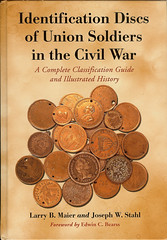 Collectors of Civil War-era numismatics have an
exciting new reference catalog to consult in building their collections.
McFarland & Co. has released Identification Discs of Union Soldiers in
the Civil War by Larry B. Maier and Joseph W. Stahl.
Collectors of Civil War-era numismatics have an
exciting new reference catalog to consult in building their collections.
McFarland & Co. has released Identification Discs of Union Soldiers in
the Civil War by Larry B. Maier and Joseph W. Stahl.This 222-page, hard-bound volume is both a guide to this somewhat neglected series, and also provides an illustrated history of the genre. Nearly 50 different types of Civil War ID tags are cataloged. The book is heavily illustrated, offering nearly 400 large, clear photographs to differentiate varieties.
As many readers know, these identification discs were sold to troops by sutlers (private merchants who followed the troops' movements). The discs were manufactured by the principal die sinkers of the period, including Joseph Merriam, S.D. Childs, Frederick B. Smith, Robert Lovett Jr., and George H. Lovett. Most obverses feature patriotic eagles and shields, or military figures such as generals McClellan, Banks, Grant, Sigel, Hooker, Sherman, Scott, or George Washington or Abraham Lincoln. The soldiers identification data was engraved on the reverse.
These private ID medals were the forerunner of military-issued ID tags. As an iconic symbol of the American GI, the dog tag has gained considerable cultural recognition, Maier and Stahl write. This book returns to the origins of the dog tag with an in-depth look at all 49 styles.
In addition to a catalog and general history, the authors provide military career details for dozens of issued ID discs, and a census of 615 known specimens by type. Rarities are given based on the census results. The issue of price can be controversial, they caution. Breakouts of known pieces by unit and style of disc are listed. The work also provides a chapter on ID disc authentication.
Authors Maier and Stahl are Civil War interpreters. They pack their volume with a great deal of historical research, provide extensive and interesting end notes, a lengthy bibliography, and a detailed index. The foreword is by Civil War historian Edward Bearss.
List price is $55. Orders can be placed toll free at 1-800-253-2187, or via the publishers web site www.mcfarlandpub.com .
Fred adds that the authors reference one of Dick Johnson's E-Slum submissions: To read the complete article, see: HOW MUSEUMS HANDLE DIES: THE SCOVILL DIE EXPERIENCE (http://www.coinbooks.org/esylum_v09n09a15.html)
NEW BOOK: THE EXCHANGE ARTIST: AMERICA'S FIRST BANKING COLLAPSE
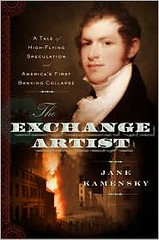 The Exchange Artist: A Tale of High-Flying
Speculation and America's First Banking Collapse rediscovers a lost
chapter in early American history: the story of Andrew Dexter, Jr. and the
seven-story skyscraper for which he amassed--and then lost--a paper
fortune.
The Exchange Artist: A Tale of High-Flying
Speculation and America's First Banking Collapse rediscovers a lost
chapter in early American history: the story of Andrew Dexter, Jr. and the
seven-story skyscraper for which he amassed--and then lost--a paper
fortune.Defying the then-predominant Puritan work ethic, Dexter financed his construction of the Exchange Coffee House by issuing millions of dollars in paper money using a string of banks stretching from Boston to Detroit. But in 1809, just as workers were putting the finishing touches on the Exchange, the financial pyramid collapsed. A now-bankrupt Dexter absconded to Canada, eventually making his way south to found the town of Montgomery, Alabama, which he named after one of his Revolutionary War heroes. Meanwhile, in Boston, the 'Change remained, a monument to Dexter's high-flying ambition and his equally monumental failure.
Speculation, fraud, luck, and failure have become important topics in American history in recent years; with The Exchange Artist, Kamensky steers the reader through the narrative of a second American founding: the birth of speculative capitalism, and uses architecture and the labor of building as (literally) concrete windows onto a vanished world.
Jane Kamensky is Associate Professor of History at Brandeis University and the author of Governing the Tongue: The Politics of Speech in Early New England and The Colonial Mosaic: American Women, 1600-1760. She is a consultant and on-camera expert for documentaries shown on PBS and The History Channel, and has made appearances on National Public Radio and the Canadian Broadcasting Corporation.
Anne Bentley adds:
To read the original lecture announcement, see: The Exchange Artist: A Tale of High-Flying Speculation & America's First Banking Collapse (http://www.masshist.org/events/more_info.cfm?eventID=295)
ANS NAMES ELIZABETH HAHN AS NEW LIBRARIAN
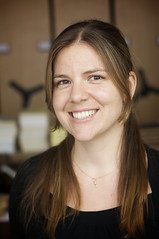 The American Numismatic Society is pleased to
announce the appointment of Elizabeth Hahn to the Francis D. Campbell
Librarianship. She took up the position on July 1, 2008. Ms Hahn comes to
the position during an exciting time as the ANS is currently in the
process of moving to its new location at One Hudson Square.
The American Numismatic Society is pleased to
announce the appointment of Elizabeth Hahn to the Francis D. Campbell
Librarianship. She took up the position on July 1, 2008. Ms Hahn comes to
the position during an exciting time as the ANS is currently in the
process of moving to its new location at One Hudson Square. Ms. Hahn is a trained librarian and completed a Master of Science in Library and Information Science from Long Island University. Her interest in specialized libraries compelled her to pursue a concentration in rare books and special collections as well as a certificate in archives, and she is particularly delighted about the extensive rare book collection at the Harry W. Bass Jr. Library at the ANS. When asked about her goals for the library, Elizabeth said that she is interested in updating the catalogs and databases in order to increase the efficiency of access to the collections. We live in a world where technology is constantly evolving and we need to keep up with those changes, she said. This is an excellent collection and it is important to convey the message to our members and the public of what resources we have and how they can be used.
Ms Hahn trained as an archaeologist and numismatist and has extensive library and museum employment experience. She holds a Master of Arts degree in maritime archaeology and history from the University of Bristol and a Master of Arts degree in classical art and archaeology from the University of Virginia. She is fluent in Italian and has a reading knowledge of German, French, ancient Greek and Latin. Elizabeth has worked on various excavations both on land and underwater in Sicily, Israel, and North America and spent a summer working at the Numismatic Museum in Athens, Greece. The ANS has played a fundamental role in my graduate studies, Elizabeth said, commenting on the research she conducted for a Masters thesis on the Greek coinage of Sicily and southern Italy. I have used the collections and resources in the past and I am thrilled to have the opportunity now to be a part of how those resources develop.
The ANS librarian position became vacant after Frank Campbell retired after working at the ANS for over half a century. During his tenure the ANS library grew enormously to a world-class library in numismatics. We are very fortunate to have found such a well educated librarian as Elizabeth, who has experience in libraries and numismatics. I am sure that the Bass Library in the new headquarters will be a popular place for academics, students and collectors, said Dr. Wartenberg Kagan, Executive Director of the American Numismatic Society.
The American Numismatic Society is celebrating its 150th anniversary in 2008. With its numismatic collections and library it is generally recognized as one of the foremost centers for numismatic research and education in the world.
ANTIQUES AUTHOR RALPH KOVEL DIES
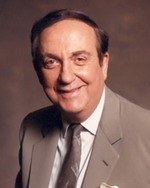 Ralph M. Kovel had a life-long interest in
antiques, and, along with wife Terry, turned that interest into a cottage
industry of publishing articles and books on antique prices and ultimately
into a career in TV broadcasting. This week that interest halted as the
88-year-old Kovel died.
Ralph M. Kovel had a life-long interest in
antiques, and, along with wife Terry, turned that interest into a cottage
industry of publishing articles and books on antique prices and ultimately
into a career in TV broadcasting. This week that interest halted as the
88-year-old Kovel died.The couple's first book, on porcelain and pottery marks, was published in 1953. They feared not to enter a field already filled with published antique price guides, but it was the nearly yearly series of the "Kovel's Antiques and Collectibles Price Guide" that earned their reputation. From that they added additional closely related books on furniture, bottles, pewter, silver and silverplate.
In this capacity they compiled the one book of greatest interest to the numismatic field, a book on limited editions. Following the popularity of the Franklin Mint and numerous imitators who issued medals, ingots, bars, plates and similar objects in limited editions, it was only natural for them to gather the prices of these objects for their 1974 book, The Kovels' Collector's Guide to Limited Editions.
In addition to gathering price data from flea markets, dealers, advertisements, and numerous contributors, they also visited many of the firms that manufactured limited editions. In 1973 Terry Kovel visited Medallic Art Company for a day gathering the most reliable information at the source. (I mentioned this in a previous E-Sylum, vol 9, no 44, art 24, October 29, 2006.)
Ralph and Terry Kovel authored a weekly syndicated newspaper column "Kovels Antiques and Collecting," in 150 newspapers. The pair also produced several programs for public television, Discovery Channel and HGTV (Home and Garden Television Network) and won two Cleveland Emmys for their television work.
For the Kovels the Limited Editions was their eighth book. Next week their 97th book, their Antique Price Guide for 2009, will be released.
For the local story in the Cleveland paper, see: To read the complete article, see: Ralph M. Kovel, expert on antiques wrote, taught (http://www.cleveland.com/obituaries/index.ssf/2008/08/
ralph_m_kovel_expert_on_antiqu.html)
To read Dick's earlier E-Sylum article mentioning the Kovels, see: A HALLOWEEN PENNY PUZZLE (http://www.coinbooks.org/esylum_v09n44a24.html)
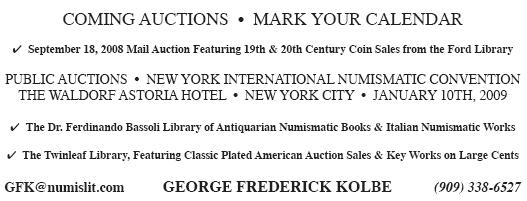
JOHN J. FORD AND THE FRANKLIN HOARD
Last week we published a note from Karl Moulton, who is working on a book about John J. Ford and the "Franklin Hoard". I didn't have them handy to scan last week, but wanted to include the following items of numismatic ephemera relating to Ford.Here is a paper Ford submitted to the Professional Numismatists Guild committee defending the authenticity of the $20 U.S. Assay Office of Gold pieces.
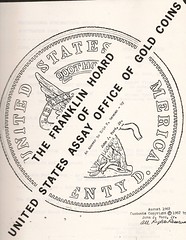
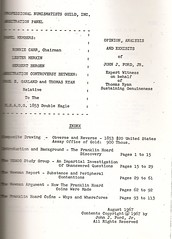
Next is Ford's "Wanted" flyer, originally produced about 1957 and reprinted by Stack's in 1999. After that is a pamphlet on Western Assay Ingots produced by Stack's about the same time.
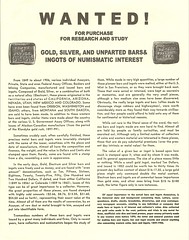
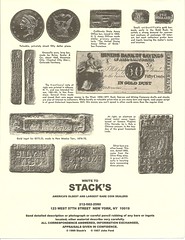

AUSTRALIA'S CHARLOTTE MEDAL PEDIGREED TO JOHN J. FORD
Immediately after this, a round of congratulatory applause broke out in the room The price reflected the importance of the piece as a tangible historical colonial work of art of the First Fleet. It is interesting to note that the medal was owned till 1981 by the late John J Ford of the USA what irony that his most valuable medal turned out to be Australian. Ford only relinquished the medal in 1981 to us as a return of favour for securing for him in our sale 4 (Nov 1980) the John Jacob Astor Fur Traders Indian Peace medal."
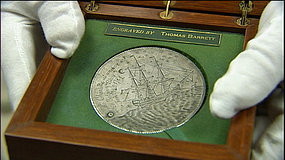
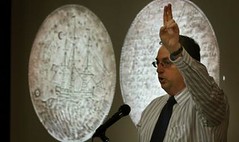
THE BOOK BAZARRE
ON CD (AND DVD) BOOK PUBLICATION
Roger deWardt Lane of Hollywood, Florida writes:
In publications apparently on CD only were World of Money, Interactive Exploration of Money Worldwide from Ancient Times to the Present Day by the Department of Coins & Medals, British Museum (1996). -Editor
Tom Michael of F+W Publications writes:
Standard Catalog of World Coins 1901-Date - Three DVD set, including the 5th edition 1801-1900, 35th edition 1901-2000 and the 2nd edition 2001-Date (this was our first DVD offering)
14th edition Standard Catalog of World Paper Money - Modern Issues - 1961-Present - released as a book with DVD and as a stand alone package
36th edition 2009 Standard Catalog of World Coins 1901-2000 - released as a book with DVD and as a DVD stand alone package
3rd edition 2009 Standard Catalog of World Coins 2001-Date - released as a book with DVD
7th edition 2009 U.S. Coin Digest - released as a book with DVD and as a DVD stand alone package
Coming later this year will also be:
12th edition Standard Catalog of World Paper Money - General Issues - 1368-1960 - released as a book with DVD and as a stand alone package and 4th edition Standard Catalog of World Coins 1601-1700 - released as a book with DVD
Most collectors are familiar with our books, some use our DVD's and many use our NumisMaster website. We have been evolving our focus from print products alone, to a broader offering in various media. We want everyone to have access to our data through whatever media form they find most useful.
Tom adds:
Because we chose to include a free DVD with all our books this year, is is hard to fully judge their popularity. Our intent was to get the data out there in digital form and get collectors used to this type of format. As a media company I am sure that we will be doing more products offering digital forms of data as the 21st Century progresses. It's a great way to make the data more flexible for individuals.
Books won't go away in our lifetimes, but many other forms for our coin data will surely emerge. Consider music - since the inception of recorded music, how many media forms have experienced popular use? Cylinders gave way to discs, 78's transitioned to 33 1/3's which competed with tape and eventually we got CD's. Now most people use MP3 digital format. Maybe some day I will have a little pocket device with the Standard Catalog of World Coins 1601-2020 in digital format?
Wendell Wolka writes:
At something close to the size of my Ohio book and as a second edition of a previous work, I doubt that the market is big enough to support a hardbound book. In addition a CD offers all color photos, enlargements of same, and an easy to use search tool at no additional cost.
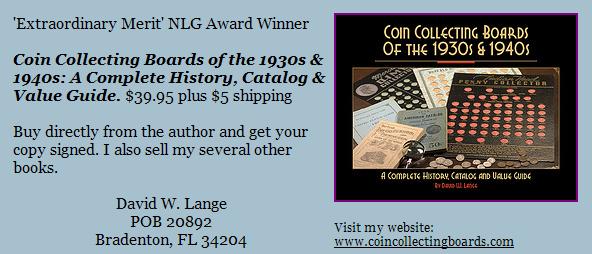
ON COUNTING THE EDGE REEDS ON A COIN
 Several readers responded to my query about
counting the edge reeds on a coin with an amazing variety of methods.
Everyone has a favorite way of doing it, each with its own pros and cons.
None eliminate the tedium of actually counting, but most incorporate tools
to make parts of the task easier. Now that these cats are out of their
bags, it will be interesting to hear if any of our experts choose to
experiment with one of the other suggested methods. -Editor
Several readers responded to my query about
counting the edge reeds on a coin with an amazing variety of methods.
Everyone has a favorite way of doing it, each with its own pros and cons.
None eliminate the tedium of actually counting, but most incorporate tools
to make parts of the task easier. Now that these cats are out of their
bags, it will be interesting to hear if any of our experts choose to
experiment with one of the other suggested methods. -Editor I suppose it would be easier to photograph a coin in a conical mirror (as is done on lettered edge coins to show the inscription), make a print and check them off by tens as you suggest, but my way was faster back in the days when a photograph meant developing film.
Bob Johnson writes:
Disassemble a regular flashlight and take out the reflector. Place the coin in the reflector and take the photograph. The entire edge will be visible. Of course with a digital camera you can put the image on your computer and blow it up to make counting much easier. I have never tried this, but I'm sure it will work with a little practice.
Dick Johnson writes:
The surest way, of course, is on a photograph, mentioned in last week's E-Sylum inquiry, and even easier on an enlarged photo. Everyone, it seems, starts counting at the top. Mark a top reed as either a "0" or "1" right on the photo. Then you can mark every fifth or tenth one. Then count the tics to get a total count.
If you are attempting to count reeds on an actual coin take a well-sharpened lead pencil and rotate the point in one of the indentations near the top. (Pencil lead retains in the indentation and can be removed with a damp cloth afterwards.) Start counting and don't stop until you are back to that marked indentation. You have better eyes than I have if you made it all around the circumference without starting over. All I can say is thank goodness the U.S. three-cent silver is not reeded. Larger coins are easier, obviously, with larger reeding.
David Lange writes:
While holding the coin between the two wheels with my hand, I then placed this trio between the tongs and released the pressure which held them open. This spring action provided a nearly hands-free tool that permitted me to rotate the coin 360 degrees while counting reeds. As for performing this last task, I painted every 20th reed with white-out, which is easily rubbed off the edge when the chore is completed, doing no harm to the coin. That gave me enough stopping points to complete the job without losing count.
Bill Bugert, Vice President of the Liberty Seated Collectors Club writes:
In a nutshell, here it is. Simply remove the reflector from an inexpensive flashlight, place the coin into the reflector under your stereo microscope, and slowly rotate the reflector with the coin while viewing the in-focus edge (i.e., reeds) through the scope. Start at an obvious flaw (all coins have them) and, count the reeds (counting out loud is best and ignore distractions) using the reticule of your scope to keep track of your position; stop for breathers at easily referenced places (e.g., nicks, lint, cracks in the collar, etc). Continue until you get to the starting reed.
You may have to initially adjust the coin in the reflector to keep it in focus for the entire counting session. With practice, you can easily and accurately count the reeds on a coin in about 2 minutes. Careful with the reflector surfaces; they scratch easily and you may end up replacing it more often than you like. One more thing, you can also photograph the edge of the coin with this technique.
Mike Hodder writes:
Obtain a small amount, a few ounces is all that's needed, of ordinary white or yellow modeling clay, the sort one may buy in a hobby shop or from a school supply store. When one wants to count a coin's reeds pull off a small piece from the clay, knead it until it's warm and soft, and then flatten it out to an appropriate length and width (three to four inches by about one inch seems to work well but the desired length and width depend on the circumference and thickness of the coin to be examined).
Next, take a felt tip marker (one with washable, not indelible, ink) and mark one reed on the coin's edge. Then, take the coin by its edge (as always), push its edge into the clay, and roll the coin along its circumference through the clay. The clay will be impressed by the reeds as the coin rolls along and the ink from the marker will show in the light colored clay each time the marked reed rolls onto it. Keep rolling until two ink marks are seen in the line of indentations.
It's a simple job to count the indentations left in the clay by the reeds starting at the first ink mark and ending just in front of the second one. A low powered glass is useful. A sewing needle can be used to mark in the clay groups of five reeds to aid in the tally. When one is finished, just ball up the clay for re-use (the tiny ink marks blend back into the clay when it's kneaded). Store it in a closed container so the clay doesn't dry out. I found a plastic quarter dollar tube worked well. The impressions in the clay can be photographed to document a count.
DICK JOHNSON ON COIN REEDING TECHNOLOGY
The collar has grooves cut on the inside wall of the aperture these form the knurls on a coin. The grooves are cut by a tool-and-diemaker . The shape of the knurl depends upon the cutting tool he uses.
When a coin is struck the metal in the blank expands to fill all the modulated relief in the obverse and reverse die, all the design devices and all the lettering. At the same instant the blank expands up against the collar. All things being right like the correct mass of the blank and the correct pressure of the press metal flows into all the openings in the collar to fill and form all the coin's knurls. That's the reeding. If there is not enough metal to completely flow into the grooves the tops of some of the knurls are incorrectly formed. Usually increasing the pressure of the strike will remedy this problem.
At this point in the press cycle the coin is frozen in its chamber. It must be removed ejected by one die pushing it out. There is a mechanism built into the press, an eccentric wheel with a kickout pin pushes the die past the edge of the collar so the struck piece is freed.
A coin with reeding must easily slide out during ejection. Other than a blank wall aperture forming a smooth edge coin reeding is the only edge treatment where this can occur. Obviously, lettering or any edge ornamentation, or even diagonal lines cannot be ejected in a coining press. (Edge lettering is an entirely different subject, completely different from our discussion here of reeding.)
We should also mention interrupted reeding. This is the technology to place a smooth area on a reeded edge piece. A smooth area is useful for placing hallmarks, edge lettering and such, in contrast to the entire circumference with reeding, which numismatists call fully reeded. It is created by leaving the inner aperture wall blank where a smooth area is desired.
In 1965 the Franklin Mint used this concept for a great commercial use. They were striking gambling tokens of similar size for many casinos in Las Vegas. They learned that patrons were carrying these tokens to other casinos. They needed a quick way to identify host tokens from those of other casinos. By using a different collar with unique pairs of reeded and blank areas for each casino the tokens would stand out when laid in rows. Joseph Segel, as president of Franklin Mint, received U.S. patent 3350802 in 1967 for this invention.
As mentioned in last week's E-Sylum, reed counting can be a diagnostic to distinguish two different coins. U.S. Assay gold coins were mentioned. A more modern example is the 1968 Canadian dime . The Canadian Royal Mint could not supply a large order for the 10-cent coin that year. In addition to what it produced it asked the Philadelphia Mint to strike the Canadian dime as well. The Ottawa Mint supplied obverse and reverse dies to the Philadelphia Mint, but did not furnish an accompanying collar. Philadelphia pressmen grabbed a collar off the rack intended for a U.S. dime, since both were of the same dimensions. That collar had a different reed count and this is the only diagnostic to differentiate which mint struck any 1968 Canadian dime.
Reeding has some beneficial advantages. It aids the blind (a reeded quarter is thus different from a smooth edge nickel of similar size), and it aids everyone in picking up and holding on to the coin. There are also some advantages in coin sorting and counting machines as well.
Placing reeding on coins is almost as old as the use of the collar in coining itself. The collar was first used by Aubin Olivier using a screw press at the Paris Mint in 1555. But we dont know which was the first coin with a reeded edge. It might have been influenced by Sir Isaac Newton who was a strong opponent of coin clipping. As Mintmaster at Britains Royal Mint he sought ways to combat shaving or clipping the edges of coins. The reeded edge was created to halt scraping or filling off metal from coin edges to melt the filings.
MORE ON THE CASTINE HOARD
Tom Kays writes:At the centennial of the hoards discovery, some of the original coins on loan from the Maine Historical Society were gathered by Sydney P. Noe, then Librarian of the ANS, and put on display in New York City. See Numismatic Notes and Monographs #100, The Castine Deposit: An American Hoard, American Numismatic Society, New York, 1942 for a detailed accounting of the coins with individual plates.
Q. David Bowers American Coin Treasures and Hoards, published by Bowers and Merena Galleries, 1997 gives a good sense of the paucity of early American coin hoards, so that understanding the Castine Hoard is key to knowing what coins circulated in the old Massachusetts Bay Colony which then included coastal Maine. Also see The Colonial NewsLetter #128 of August 2005, Second Thoughts on a First Rate Hoard: Castine Revisited.
PHOTOS: J.L POLHEMUS COUNTERSTAMP ON FRENCH COIN
Last week Jeff Tolson wrote:Jeff provided these photos of the piece (click to see larger versions). Neat find!
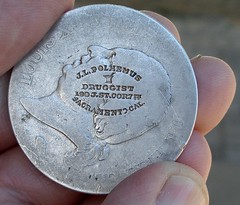
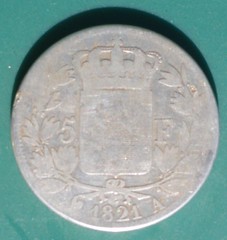
QUERY: J. T. JONES COUNTERSTAMP ON A $50 GOLD SLUG
Dave Hirt writes:There are very few known U.S. merchant counterstamps on gold coins. I did not recall this one. Are any of our readers familiar with it?
An Internet search turned up a reference to a J. T. Jones in San Francisco. The same document lists another San Francisco merchant at the corner of Commercial and Montgomery streets. The search also turned up a reference in (surprise!) The E-Sylum. In the Christmas Eve 2000 issue, Mike Hodder submitted a Press Release from Stack's about their upcoming January 2001 sale.
Stack's online auction archive goes back only to July 2003, so I was unable to get an image of the coin or lot description. I asked Mike Hodder, who writes:
So I went to my shelf and pulled out my copy of Don Kagin's 1981 book, Private Gold Coins and Patterns of the United States. The photo of the well-worn coin (see below) is not the best - perhaps it was taken from a catalog. From the book's description:
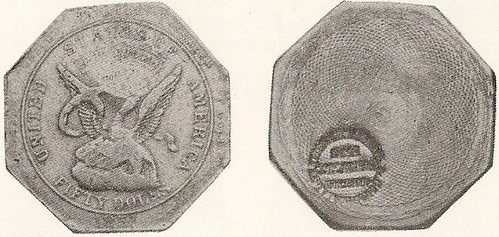
Can anyone provide a better image of the coin or its counterstamp? Is its current owner among our readership? Many thanks to Dave Hirt for bringing up the topic. Interesting counterstamp on an unusual host coin.
To read the complete E-Sylum article, see: STACK'S JANUARY SALE (http://www.coinbooks.org/esylum_v03n53a06.html)
To view the complete reference, see: Petition Of Citizens Of San Francisco For The Repeal Of The Mortgage Tax Law (1 of 2) (http://freepages.genealogy.rootsweb.ancestry.com/~npmelton/SFRepeal1.htm)
WILL W. NEIL, NUMISMATIST BY INSTINCT
Harry Waterson writes:Mr. Neil's Letterheads
Will W. Neil, a member of the A.N.A., who conducts a pharmacy at Baldwin, Kan., uses a letterhead for his correspondence, which reads as follows:
Numismatist by Instinct - Pharmacist from Necessity
Baldwin, Kansas.
I hope Mr. Neil was hugely successful in both pursuits.
- 1913 Liberty Head Nickel
- 1894-S Dime
- 1876-CC Twenty Cent Piece
- 1838-O Half Dollar
- 1804 Dollar
- 1870-S Dollar
- 1885 Trade Dollar
From the PCGS web site:
To read the complete article, see: Ten Most Famous United States Ultra Rarities: Will W. Neil (http://www.pcgs.com/setregistry/alltimeset.aspx?s=9505)
PISTRUCCI WATERLOO MEDAL ELECTROTYPES
Regarding last week's mention of the Pistrucci Waterloo medal, Jonathan Brecher writes: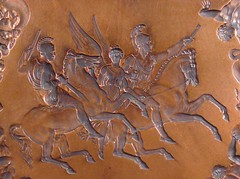 If you like the Pistrucci medal, here are some
pics you might enjoy. These are negative-image (incuse and reversed)
electro-somethings of the Pistrucci Waterloo medal.
If you like the Pistrucci medal, here are some
pics you might enjoy. These are negative-image (incuse and reversed)
electro-somethings of the Pistrucci Waterloo medal.These are the correct size, with the medal part measuring about 5.5 inches in diameter, and a total diameter of about 6.5 inches including the broad rim. The rim and the backside of each half are covered in some sort of fairly hard waxy substance.
I've shown these to several people, and nobody seems to know what to make of them. I've had several guesses that are generally plausible, but nothing that I feel is quite right (in particular, the presence of the wax seems like it ought to be important, and none of the guesses can explain it.)
I've found several sale records of positive-image cliches (including sets that were produced by the Waterloo Committee in 1969), but nothing for negatives. Another mystery...

To view all of Jonathan's photos as a slide show, see: Pistrucci Waterloo Medal electrotypes (http://www.flickr.com/photos/coinbooks/sets/72157606974566395/show/)
QUERY: SIX-POINTED STAR STAMP ON U.S. PAPER MONEY
Has anyone else encountered this stamp? Any idea who made it or why? -Editor
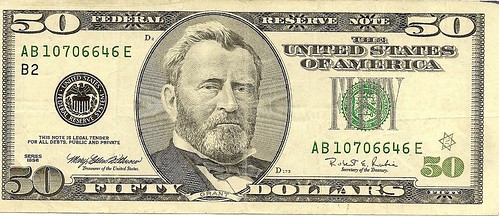
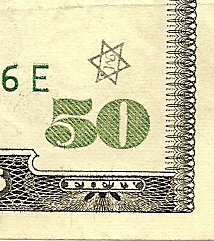
QUERY: TRANSLATION SOUGHT FOR 2004 ATHENS OLYMPICS GOLD MEDAL
Leon Worden writes: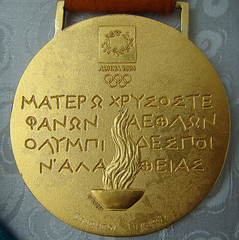 Can anyone translate the inscription on this
gold medal from Athens 2004? It belongs to Olympic home run record-holder
Crystl Bustos (USA Softball, 2000-gold, 2004-gold, 2008-silver), and she'd
like to know what it says. [Other images of '00, '04, '08 medals available
to fellow E-Sylum inmates upon request.] Thanks.
Can anyone translate the inscription on this
gold medal from Athens 2004? It belongs to Olympic home run record-holder
Crystl Bustos (USA Softball, 2000-gold, 2004-gold, 2008-silver), and she'd
like to know what it says. [Other images of '00, '04, '08 medals available
to fellow E-Sylum inmates upon request.] Thanks. PRESIDENT BUSH GETS A COIN FROM THE CIA
Bush then walked into the agency's cafeteria where he was greeted with a standing ovation by the 2,000 employees inside. Clearly pleased, he told them, "I appreciate your service more than you could possibly know."
Bush then took a seat at a table with two dozen junior employees. They included analysts, clandestine operatives, scientists and engineers, and support personnel. In between bites, he asked them about their jobs and where they have served overseas. One analyst, who played a key role for the CIA in identifying the nuclear reactor that was being built in Syria with North Korean assistance, gave the president a bronze commemorative coin that Hayden had presented to each agency employee who was directly involved in that intelligence effort.
The 3-inch diameter coin was inscribed with, "Syria-North Korea Project" and the words, "No Core, No War."
During the visit, which went two hours longer than scheduled, we hear that the president shook hands, gave hugs, and signed autographs, even on $5 and $10 bills some employees gave him for signature because they didn't have another piece of paper handy.
/2008/08/15/a-cia-standing-o-for-president-bush.html)
BASEBALL CARD COMPANY GIVES AWAY MONEY
Topps Treasury Basketball, which will go live the week of Sept. 29, will offer one autographed card and one Rip card in every 18-pack box. The Rip cards bring back the card-within-a-card concept that has been tried a few times in the hobby in the past, but this time Topps is upping the ante by offering some very tempting possibilities within the Rip card.
There will be no debating the value of the other insert cards titled, Theyre Money. Actual $10, $20, $50, $100, $500 and $1,000 bills will be inserted into the Rip cards. A total of 429 cards will contain some form of cash.
CORRECTIONS TO THE AUGUST 24, 2008 ISSUE
Last week I wrote: "Jim Neiswinter has been studying the famous 1873 Levick plate for some time." Where that date came from, I'll never know. The plate was published in the April 1869 issue of the American Journal of Numismatics.Joe Boling pointed out my misspelling of a subscriber's name - it's Phil Iversen, not Iverson.
With tongue in cheek, Alan Luedeking reported an error in this excerpt published in last week's issue. It was taken from the description of the cover lot in George Kolbe's 106th sale.
Alan writes: "Was Snowden's restriking of medals in any way connected with his ability to work backwards in time?"
OK, Mr. Smartypants - Snowden's tenure as Mint Director began in 1853, not 1863.
FEDERAL RESERVE BANK OF CHICAGO EXHIBIT
Howard Berlin filed this report last Saturday, but I was unable to get it into last Sunday's issue. He wrote:I am attaching pictures of all three exhibits. The last one is of my oldest son (who lives in Chicago), my wife, and the guy with the Berlin shirt and hat is me.
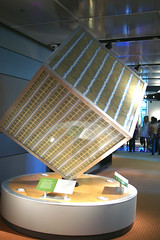
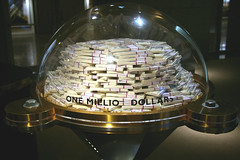
HOWARD BERLIN VISITS NUMISMATIC SITES IN SCOTLAND
In subsequent emails Howard Berlin added: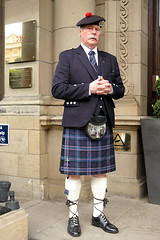 I returned home from Chicago and left again for
Scotland (Edinburgh and Glasgow). I will be visiting numismatic
collections at the National Museum of Scotland (Edinburgh), The Bank of
Scotland Museum on the Mound, and the Hunterian Museum (Glasgow) in
between some pubs and distilleries.
I returned home from Chicago and left again for
Scotland (Edinburgh and Glasgow). I will be visiting numismatic
collections at the National Museum of Scotland (Edinburgh), The Bank of
Scotland Museum on the Mound, and the Hunterian Museum (Glasgow) in
between some pubs and distilleries.This distinguished gentleman is the doorman of the 5-star Balmoral Hotel decked out in full regalia, including the small dagger at the top of the right sock. Contrary to common belief, NORMAL men wearing kilts DO WEAR underpants! (no, he didn't demonstrate his)
This week I'm in Scotland. Right now I am at the Hunterian Museum at the University of Glasgow looking at the some of the coins of Dr. William Hunter, who collected just about everything in addition to coins. Across the street from the museum is the Hunterian Art Museum where there are a few more coins and next to it is the university library. I was told by the museum's senior curator, Dr. J D Bateson, that it holds approximately 100 of Hunter's numismatic books that go back to the 16th or 17th century. Apparently you do not need to make advance arrangements to see these, just sign in.
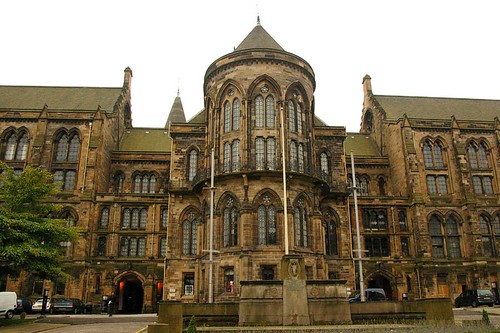
PHOTOS ILLUSTRATE ZIMBABWE'S INFLATION
Zimbabwe as an example, this country's entire population of over 12,000,000 are billionaires. In fact, many are trillionaires, or even quadrillionaires. in case you're unfamiliar with "quadrillions, " a quadrillion is a million billion, or a 1 followed by 15 zeros
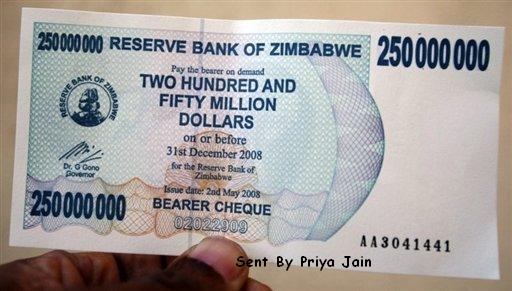
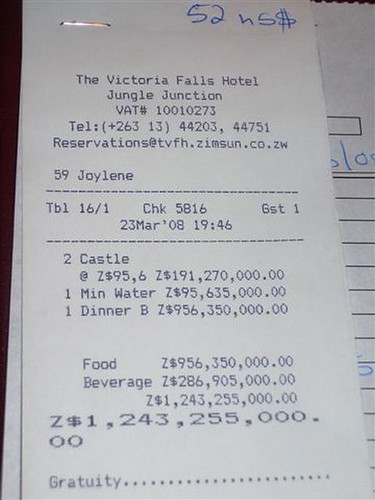
VIENNA'S MEDIEVAL SYNAGOGUE AND TOKENS
Nine lead tokens, the size of large coins, were also found. They were embossed with formal designs, such as an eagle, a rosette and one with two kings holding a crown, and they are unique in Austria. Though not definitely of Jewish origin, it is tempting to see them as associated with the money-lending trade, and they may have counted as ersatz money for use among the Jewish merchants.
Today these remains are beautifully exhibited in the underground museum, which is regularly visited by non-Jewish schoolchildren to give them a flavor of early Jewish life in their capital.
To read the complete article, see: Vienna's underground synagogue (http://www.jpost.com/servlet/Satellite?cid=1219218610072
&pagename=JPArticle/ShowFull)
JERUSALEM MAN ARRESTED FOR SELLING ANCIENT COINS TO TOURISTS
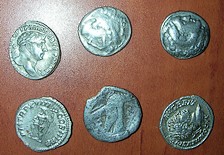 A 43-year-old Arab resident of east Jerusalem
has been arrested for allegedly posing as a city tour guide and selling
tourists various rare antique coins, the Israel Antiquities Authority said
Tuesday.
A 43-year-old Arab resident of east Jerusalem
has been arrested for allegedly posing as a city tour guide and selling
tourists various rare antique coins, the Israel Antiquities Authority said
Tuesday. The suspected antiquities thief was nabbed red-handed on Sunday in the Old City of Jerusalem by the state-run archeological body's anti-theft division in the midst of making a sale to unsuspecting tourists.
The suspect was found to be carrying around 100 impressive antique coins of various shapes and sizes, including Roman coins and a motley collection of other coins dating back to the Hellenistic Period.
The coins, which were taken from various archeological sites across the country, are valued in the thousands of dollars.
"It is important that the public know that antique coins which are being offered for sale on the street and in markets were illegally excavated at archeological sites throughout Israel," said Shai Bar-Tura, the deputy head of the Antiquities Authority's anti-theft division.
"Our history is being sold for greed," he said.
The phenomenon of antiquities theft has taken on gold-rush dimensions with an antiquities site now plundered nearly every day on average.
To read the complete article, see: Man posing as J'lem tour guide nabbed for selling ancient coins to tourists (http://www.jpost.com/servlet/Satellite?cid=1218710408521&
pagename=JPArticle/ShowFull)
COURT RULES CLEVELAND BUILDING LEASE IS PAYABLE IN GOLD
Because the price of gold has shot up since 1912, a lower court must now determine what the 35,000 gold coins that the lease calls for in annual rent is worth in U.S. dollars, under the ruling by the 6th U.S. Circuit Court of Appeals, reports the Associated Press.
The gold coin requirement had apparently been long forgotten until 216 Jamaica Avenue bought the building in 2006. It tried to enforce the payment provision, and sued when the tenant balked.
To read the complete article, see: 1912 Gold Coin Lease Payment Term is Enforceable, 6th Circuit Rules (http://www.abajournal.com/news/1912_gold_coin_lease_payment
_term_is_enforceable_6th_circuit_rules/)
To read a related article, see: Gold Rush: Thompson Hine on Losing End in Landlord/Tenant Case (http://amlawdaily.typepad.com/amlawdaily/2008/08/pay-in-gold-tho.html)
OHIO COURT REFUSES PAYMENT OF FINE IN PENNIES
Judge Edward J. Elum and Massillon Municipal Court deputy clerk Shane Jackson both declined to accept the delivery of the pennies thrown into a box with packing peanuts and mailed by Philip B. Simer, 27.
Simer spent $14.31 to mail his payment to the court, which sent the heavy package back to him on Friday.
Simer was found guilty of two traffic violations earlier this month.
He was ordered to pay $243 -- or $50 every two weeks -- in fines and court costs.
He used the pennies to make his first $50 payment.
A postal worker had to deliver the large brown box with a dolly, but the Elum and Jackson both refused receipt.
Simer said he has no intention of paying the fines in anything but pennies.
To read the complete article, see: Court refuses payment in pennies (http://www.wkyc.com/print.aspx?storyid=95234)
FEATURED WEB PAGE: ORIENTAL COINS DATABASE
This week's featured web page is ZENO.RU, the Oriental Coins Database. It is recommended to us by Dan Freidus.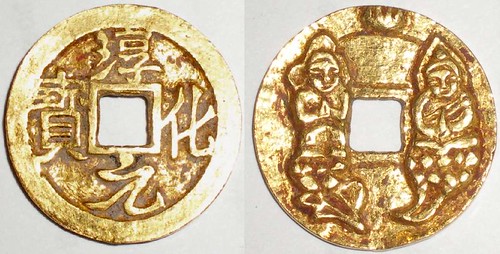
http://www.zeno.ru/

